No game is more decisive in British football than the Old Firm.
The Glasgow Derby sees Scotland’s two biggest clubs, Celtic and Rangers, go head-to-head in their constant tug-of-war for domestic domination.
Celtic have clearly been more successful over the past decade.
Since 2012, Rangers have only managed to win Scotland’s top flight on one occasion, with Celtic running away with the league time and time again.
Celtic’s grip on their continual domestic triumphs doesn’t appear to be weakening.
They scored nine league goals without conceding any in their opening three games.
Rangers, on the other hand, looked to be heading for another season of turmoil.
After drawing their opening game against Hearts, they managed to win their next two matches.
Already falling behind their rivals in the league and failing to qualify for the UEFA Champions League has left Rangers’ fans utterly disappointed with their start to the season.
Both teams’ form was reflected in the game.
Despite Rangers’ excellent start, Celtic soon began to tear them apart through their rapid counterattacks.
A convincing 3-0 victory puts Celtic firmly in the driving seat, heading towards their fourth consecutive title — though it must be said it is still early days in the season.
In this tactical analysis, we will highlight where Celtic excelled, leading them to their dominating display.
Comparatively, we will provide an analysis of where Rangers failed and what the Gers needed to execute better if they were to have any chance of winning this match.
Lineups
Celtic’s starting lineup has seen a variety of personnel used throughout their opening games in Brendan Rodgers’ 4-3-3 system.
One area that has remained unchanged is defence; Premier League winner Kasper Schmeichel continued in nets, while the back four was made up of Canadian right-back Alistair Johnston, a centre-back pairing of Cameron Carter-Vickers and Liam Scales, and Scotland international Greg Taylor retaining his place at left back.
The midfield three saw club captain Callum McGregor playing as the deepest midfielder, with Paulo Bernardo and Reo Hatate operating as number 8s.
The front three saw two changes from Celtic’s win over St Mirren.
Maeda was reinstated on the left-hand side of the attack, and German Nicolas Kühn continued on the opposite flank.
Starting as a centre-forward was the deadly Kyogo Furuhashi, who, before this game, had scored six in 13 games against Rangers.
Rangers had several players in their starting lineup who were getting their first taste of the Old Firm.
In front of ‘keeper Jack Butland, captain James Tavernier started at right-back, and John Souttar continued at right centre-back.
The back four was completed with two new summer arrivals in the form of Robin Pröpper at left centre-back and Jefte at left-back.
In possession, Connor Barron played as Rangers’ deepest midfielder, with Mohamed Diomande and Dujon Sterling playing in more advanced positions.
The front three consisted of Rabbi Matondo, Cyriel Dessers and Václav Černý who had all been in impressive form in the lead up to this match.
Penetration Down The Flanks
When you statistically compare the number of crosses both sides delivered, Rangers came out on top.
They delivered 15 crosses with an accuracy of 33%, whereas Celtic only managed 10 with a success percentage of 30%.
However, the story lies in these crosses’ quality and location.
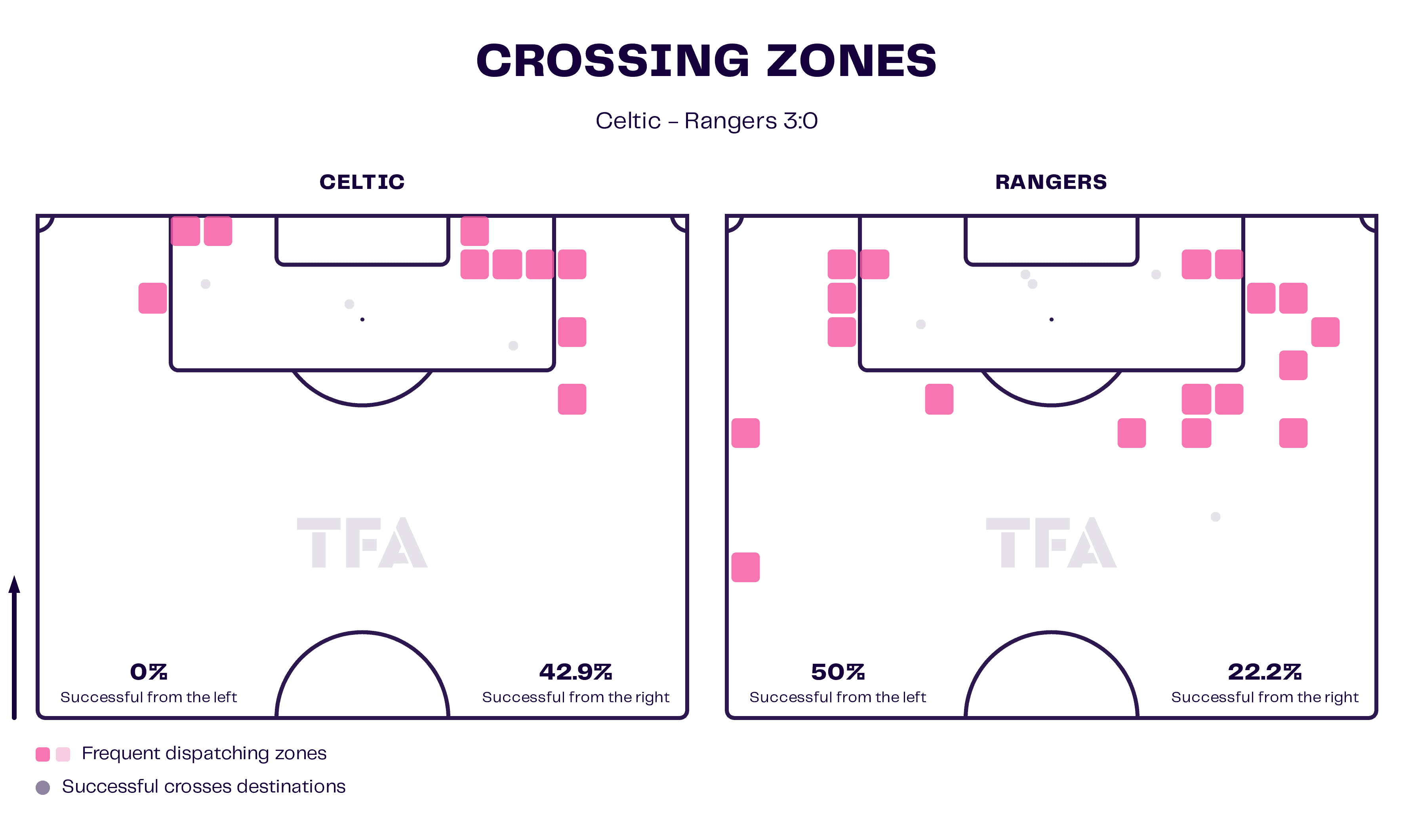
This graphic compares the areas from which Celtic delivered their crosses.
More than half of their crosses came from just inside the penalty box, which has been discovered to be where the greatest number of assists from crosses occur.
Rangers played a significant number of crosses, yet a substantial number were from deep areas, with Celtic having double the number of crosses inside the penalty area.
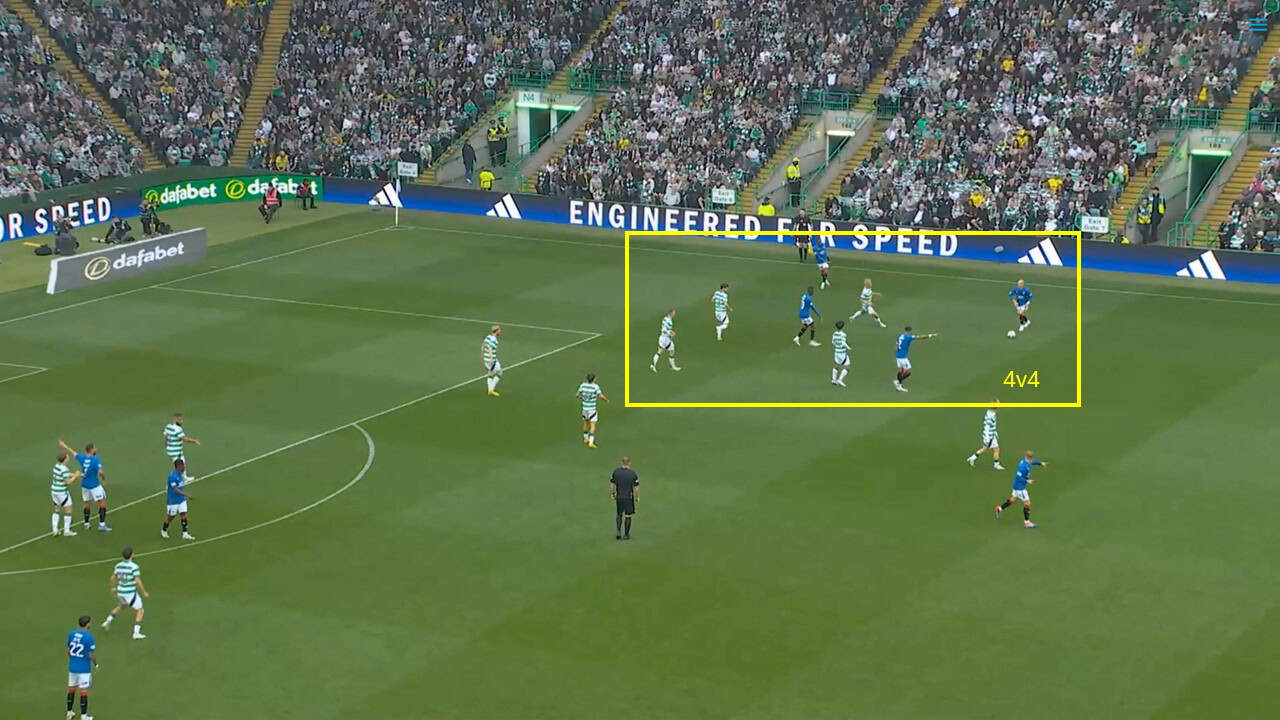
This leads to the question, how were Celtic able to get into this area so often?
First, it’s important to consider Rangers’ failings to do likewise.
Here, we see that Rangers are on the right-hand flanking a 4v4 situation.
Celtic have prevented an overload on the flank and have their remaining defenders set to deal with a cross.
A lack of fluidity and imagination in the attack leads to Černý playing a deep cross that is easily intercepted.
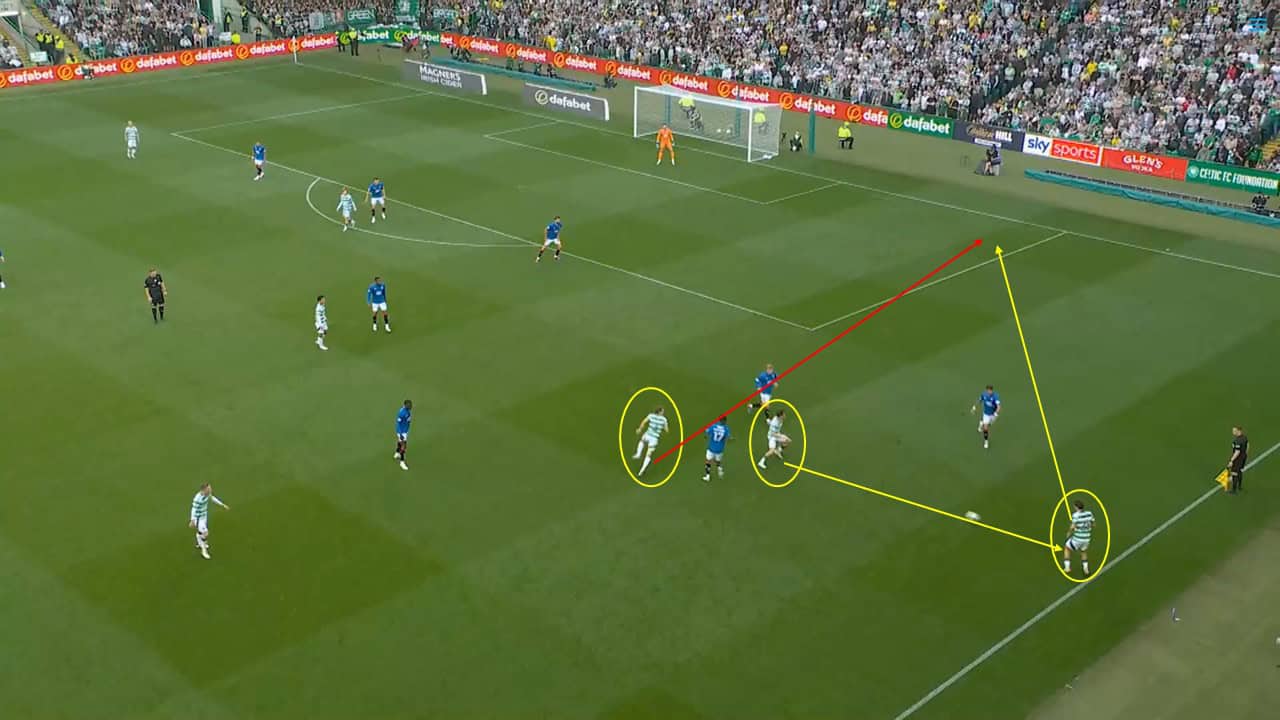
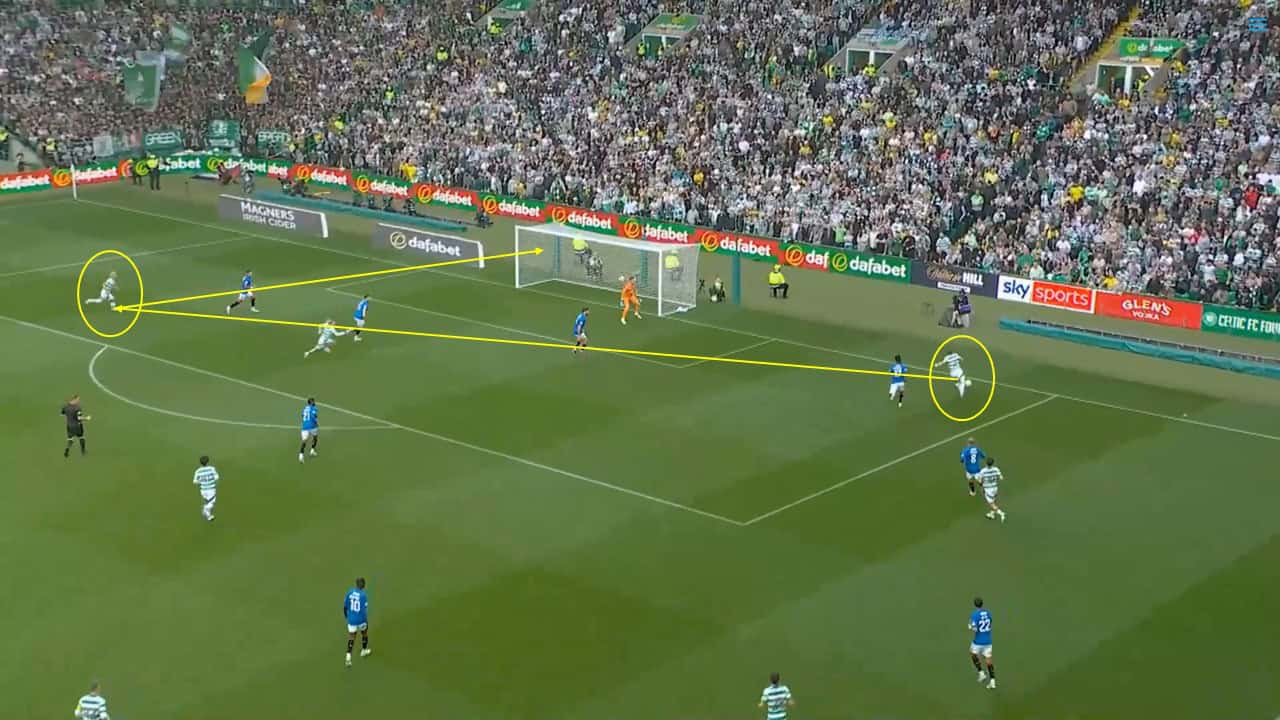
Where Celtic gained joy when attacking the flanks was not only through their ability to overload the wide areas, but it was their use of rotations that led to them getting into some dangerous areas.
In this situation, Celtic are in a 3v3 on the right flank; Nicolas Kühn receives the ball marked and quickly lays it off to Paulo Bernardo.
During this exchange of passes, Alistair Johnston makes a third-man run in the half-space.
Benardo plays the ball into his path, allowing Johnston to cut the ball back for Maeda, who slots the ball home for The Hoops’ first goal of the afternoon.
Taking Advantage Of The Midfield Overload
Under Ange Postecoglou, Celtic utilised inverted full-backs in their tactics in an attempt to break down the packed defences they so often faced; Brendan Rodgers has continued to use this during his side’s build-up play.
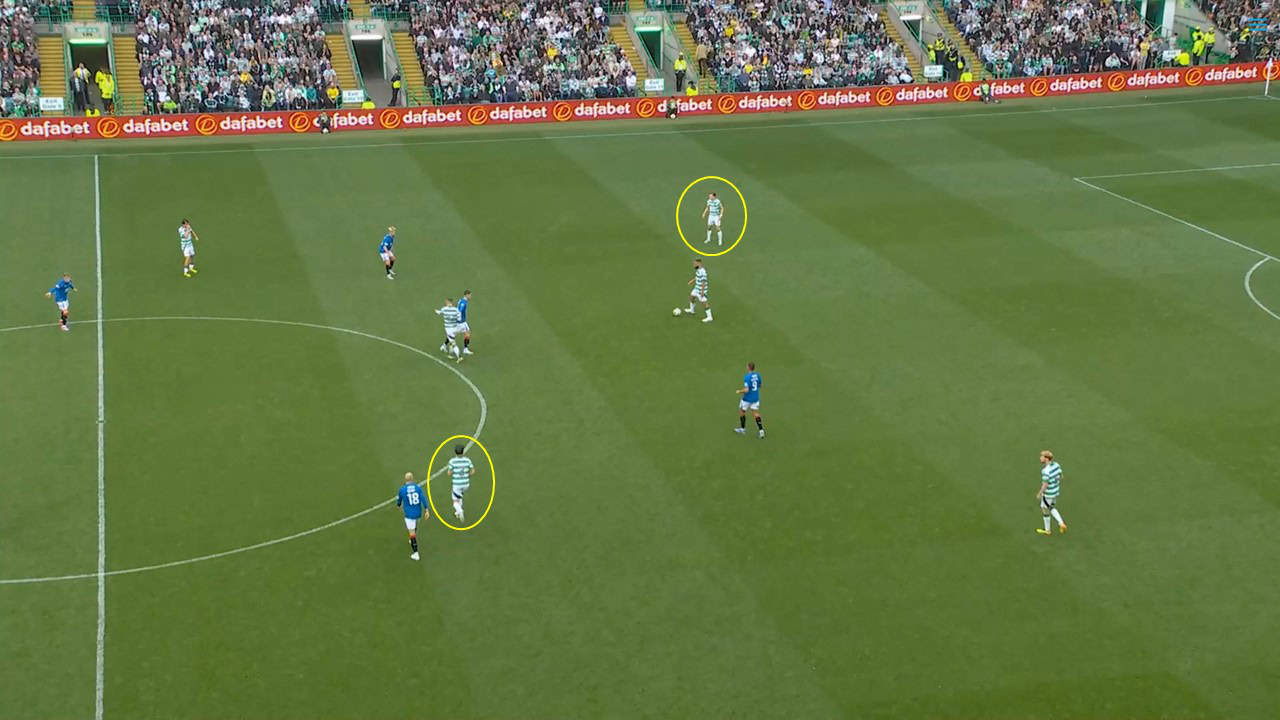
Here, Greg Taylor comes into midfield, and Alistair Johnston tucks into the backline, creating a back three and helping to create an overload in the middle of the park.
This took advantage of Rangers’ man-to-man-marking as it drew their wide attackers inside, seeing them take up extremely narrow positions, isolating Celtic’s wingers against Rangers’ full-backs.
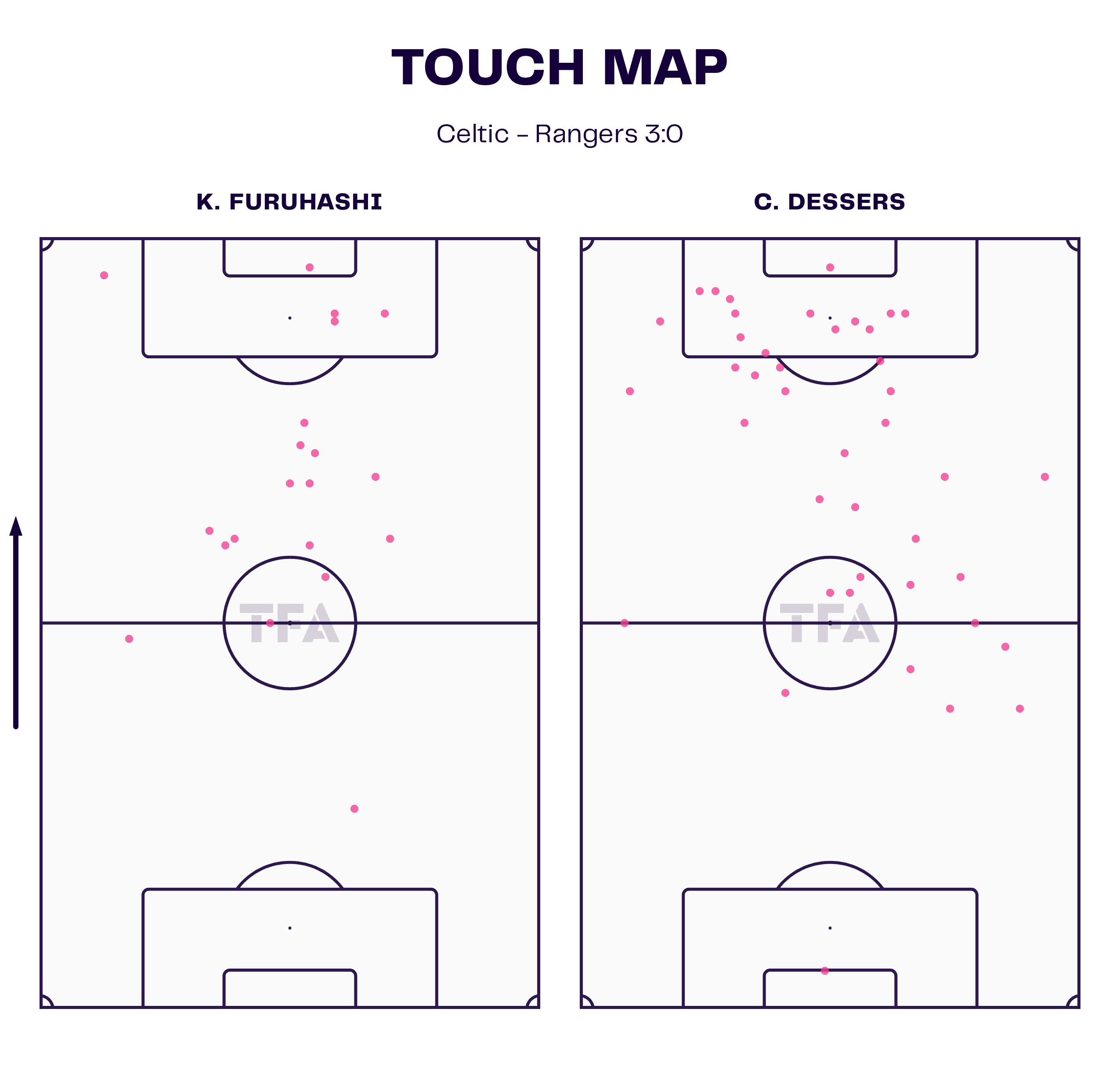
This was key in giving Celtic a platform that allowed them to play forward.
However, the story of this match could so easily be told through the contrasting performances of both sides’ number 9s.
Both Dessers and Kyogo were key characters in allowing their side to progress the ball — as seen from the graphic above.
Both received the ball a considerable number of times in the area between the opposition’s midfield and defensive lines.
Yet, the decision-making of both individuals and their team’s ability to support their respective forwards in possession was vastly different.
Rangers did have success when playing out from the back.
They elected for a patient build-up, inviting Celtic to press to play around and through their defensive structure.
Rangers did have success when doing this; they had more possession than Celtic and played more progressive passes in the game than their great rivals.
Yet the issue was what happened after the ball was progressed.
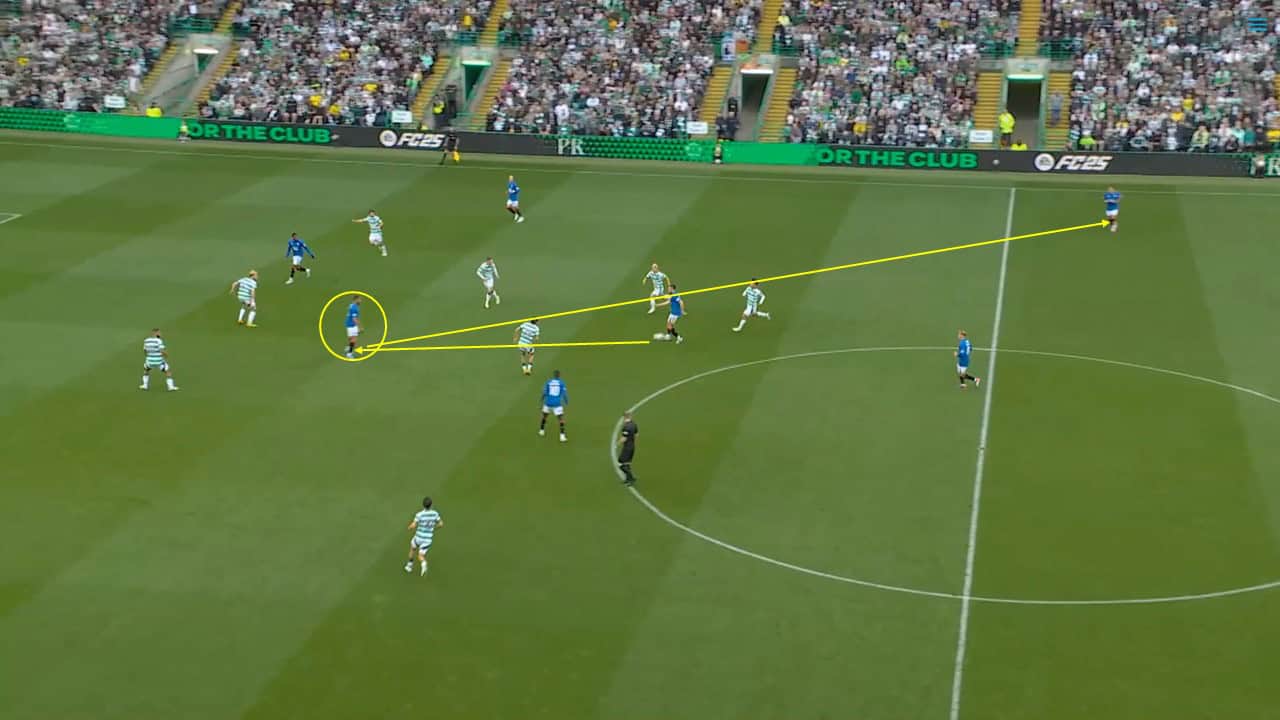
In this situation, Souttar impressively drives out of defence.
He then fires the ball into the feet of his centre-forward, Dessers.
The Nigerian forward, without thinking, plays the ball first time back to Tavernier at right-back, meaning that the build-up play must recommence.
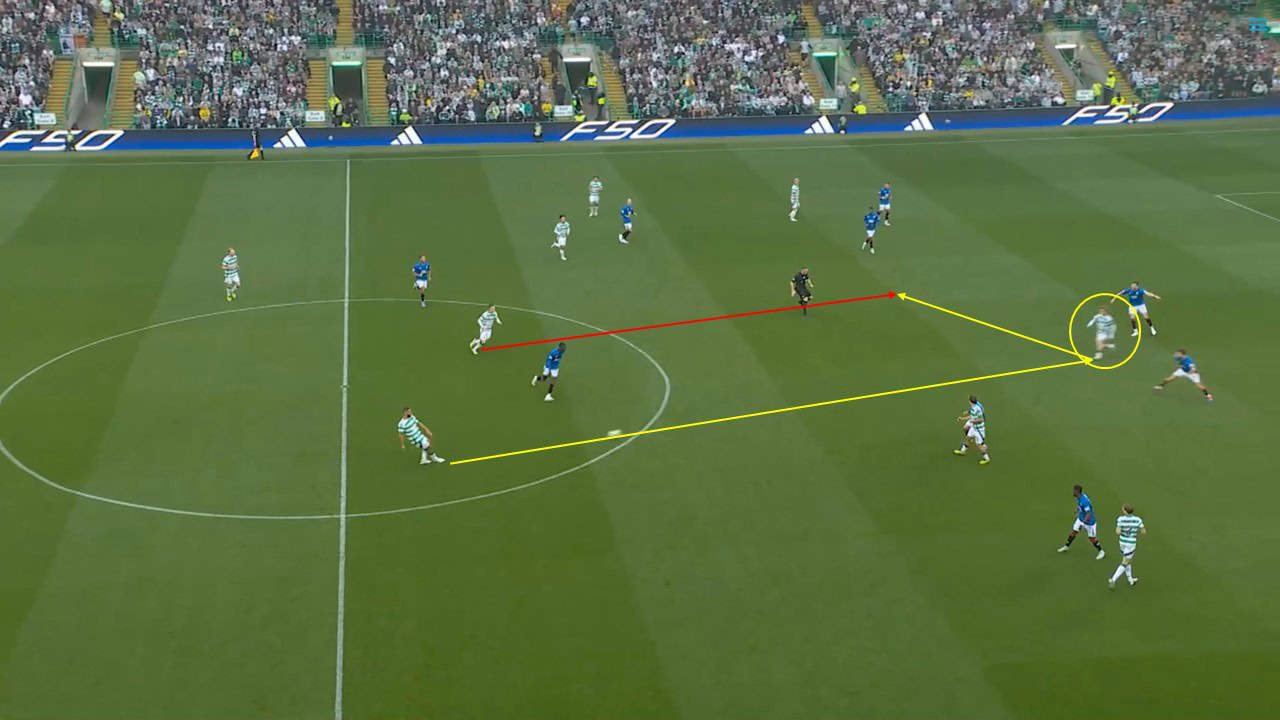
This is vastly different from how Celtic continued to attack once they played forward.
Here, Kyogo drops to receive a line-breaking pass from Carter Vickers.
This is intelligent from the Japanese international as it provides an option for the man on the ball with all of Celtic’s midfielders closely marked.
As the ball travels to Kyogo, McGregor makes a third-man run, allowing him to break free of marking and receive a pass in the final third from his centre-forward — this contrast happened throughout the match.
Kyogo’s creativity and ability to decide between whether to pass or turn allowed Celtic to attack with speed.
Dessers continuously laid the ball off without it leading to any further progression, preventing his team from creating dangerous attacking scenarios.
Attacking Transitions: Where The Game Was Won And Lost
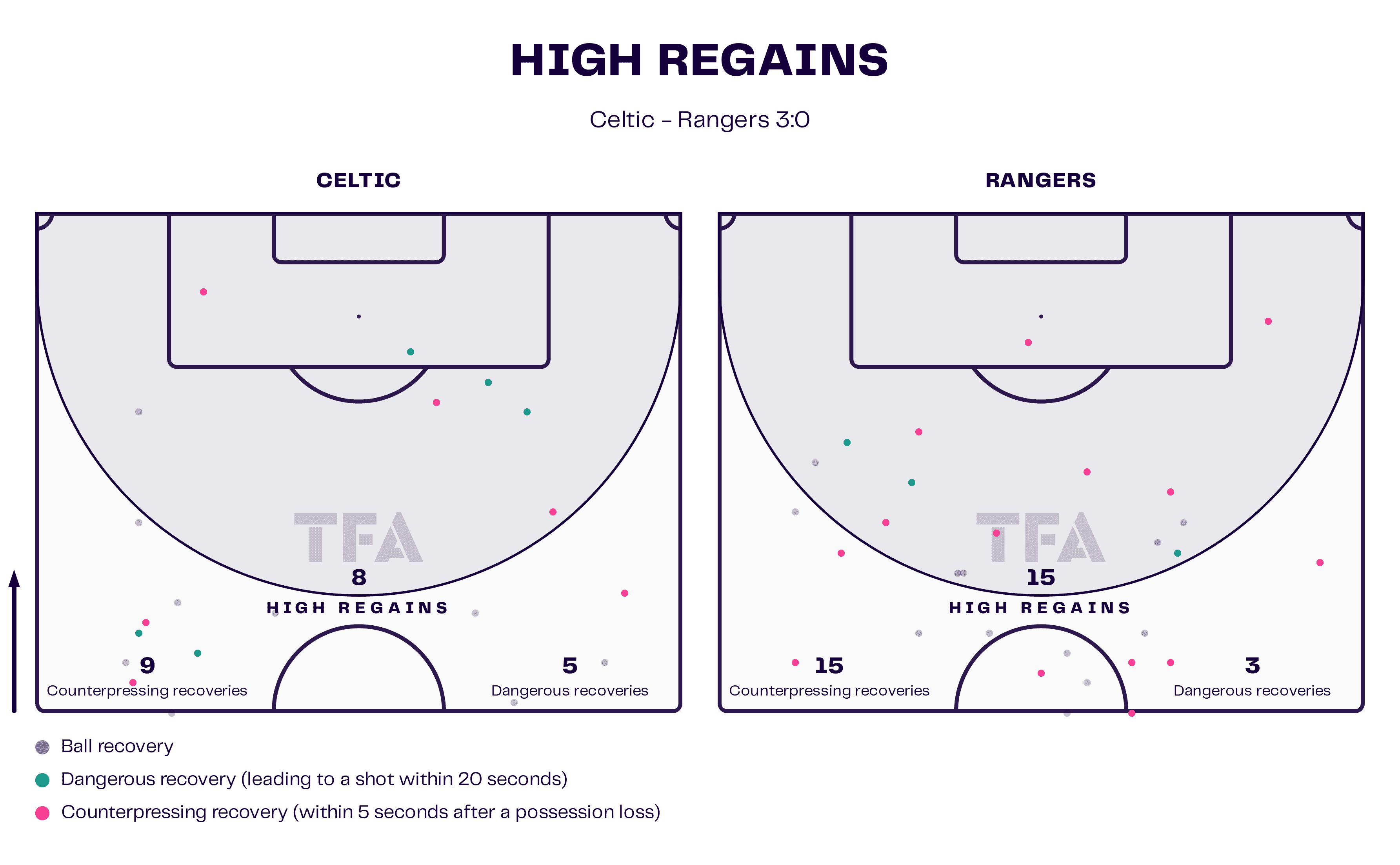
Rangers started the game with a real intent to put Celtic under pressure, seeking to press them aggressively and win the ball high up the pitch.
As seen from the graphic above, Rangers were successful at this.
They had more high regains, demonstrating the effectiveness of their press.
Yet it can be seen through the Teddy Bears’ fewer dangerous regains and their wasteful nature as to why they failed to find the net against Celtic.
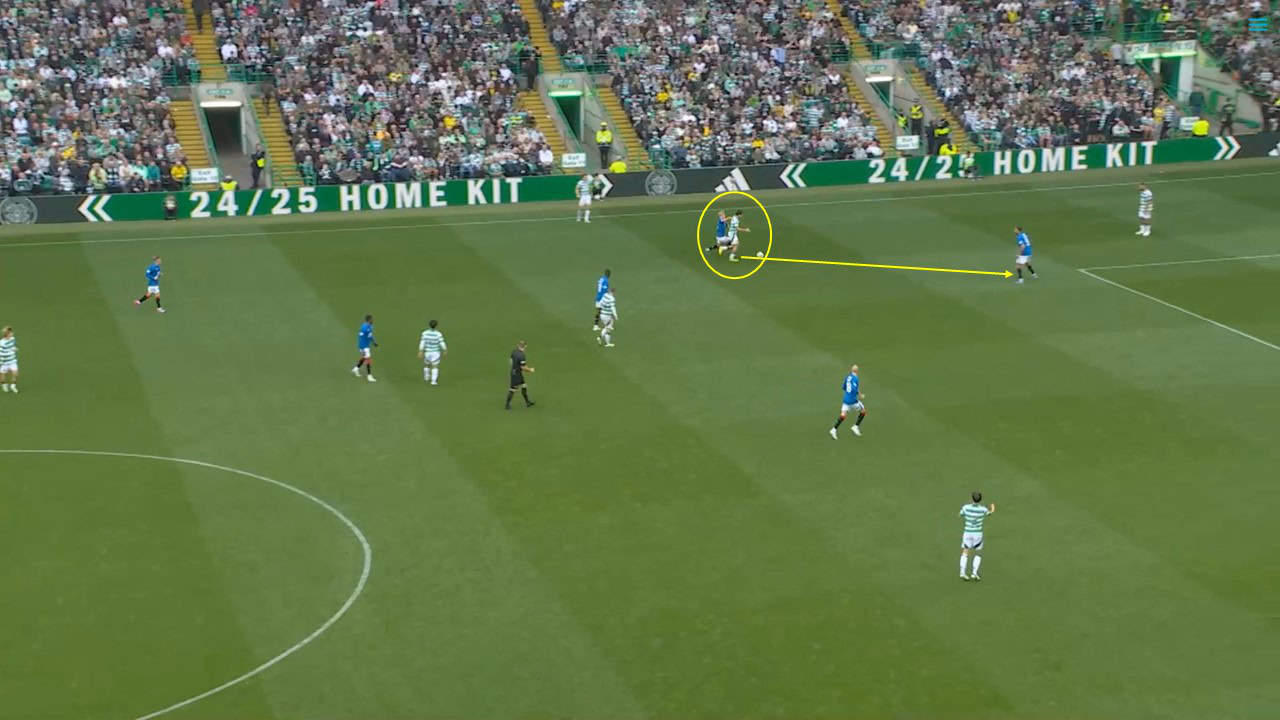
As the ball is played to Paulo Bernardo, Ross McCausland puts the Celtic midfielder under serious pressure.
Rangers are in a compact shape, preventing the Portuguese midfielder from finding an easy out ball.
McCausland’s press sees him nick the ball off his opponent and then play Dessers through on goal.
However, the forward has a tame shot that’s easily saved by Kasper Schmeichel.
Rangers had their opportunities in the match, highlighted in the fact that they had an expected goals total of 1.63.
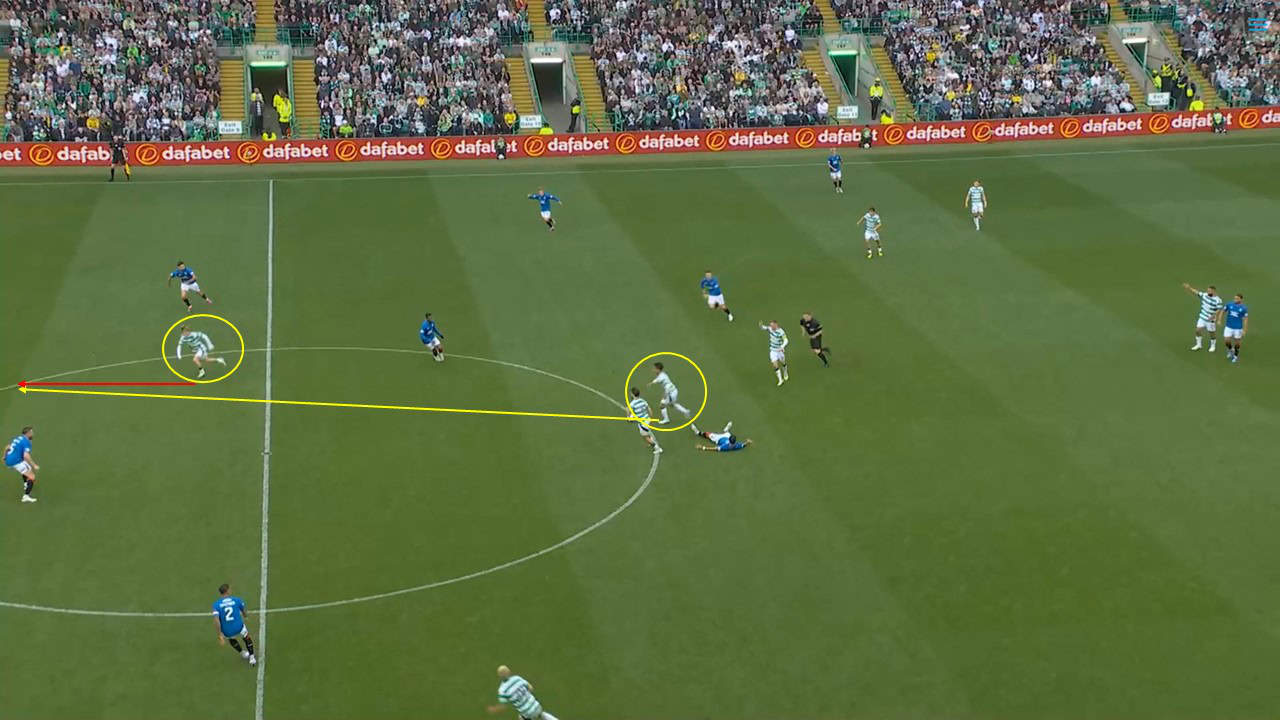
Unlike Rangers, Celtic took advantage of their opportunities to counterattack.
Celtic were incredibly impressive at playing forward in their first one or two passes after regaining possession.
In this situation, after the ball is won, Hatate looks to play forward.
Kyogo’s piercing run is made between the Rangers’ two centre-backs, offering an excellent forward option.
Hatate plays in his fellow countryman through on goal, who uncharacteristically fails to convert this opportunity.
Conclusion
It’s evident that there’s a gulf in class between the Glasgow giants.
Celtic’s speed and fluidity in attack saw Rangers being torn apart.
Two of Celtic’s three goals came just seconds after they won back possession.
Rangers failed everywhere Celtic succeeded.
They lacked cohesion in attack and wasted the clear-cut chances that they did have.
Phillippe Clement has some serious work to do if he’s to have any chance of securing Rangers’ 56th title.

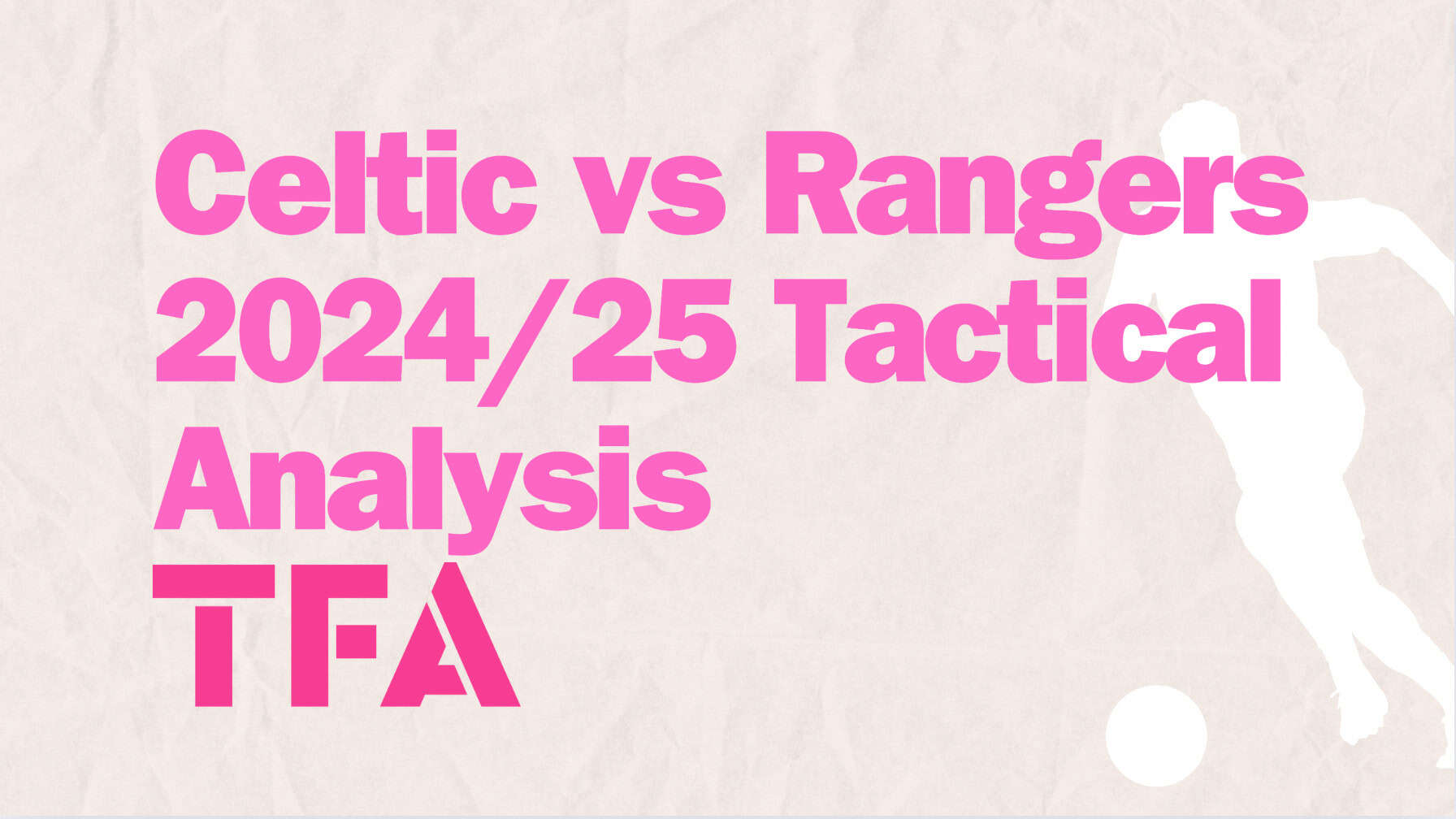



Comments